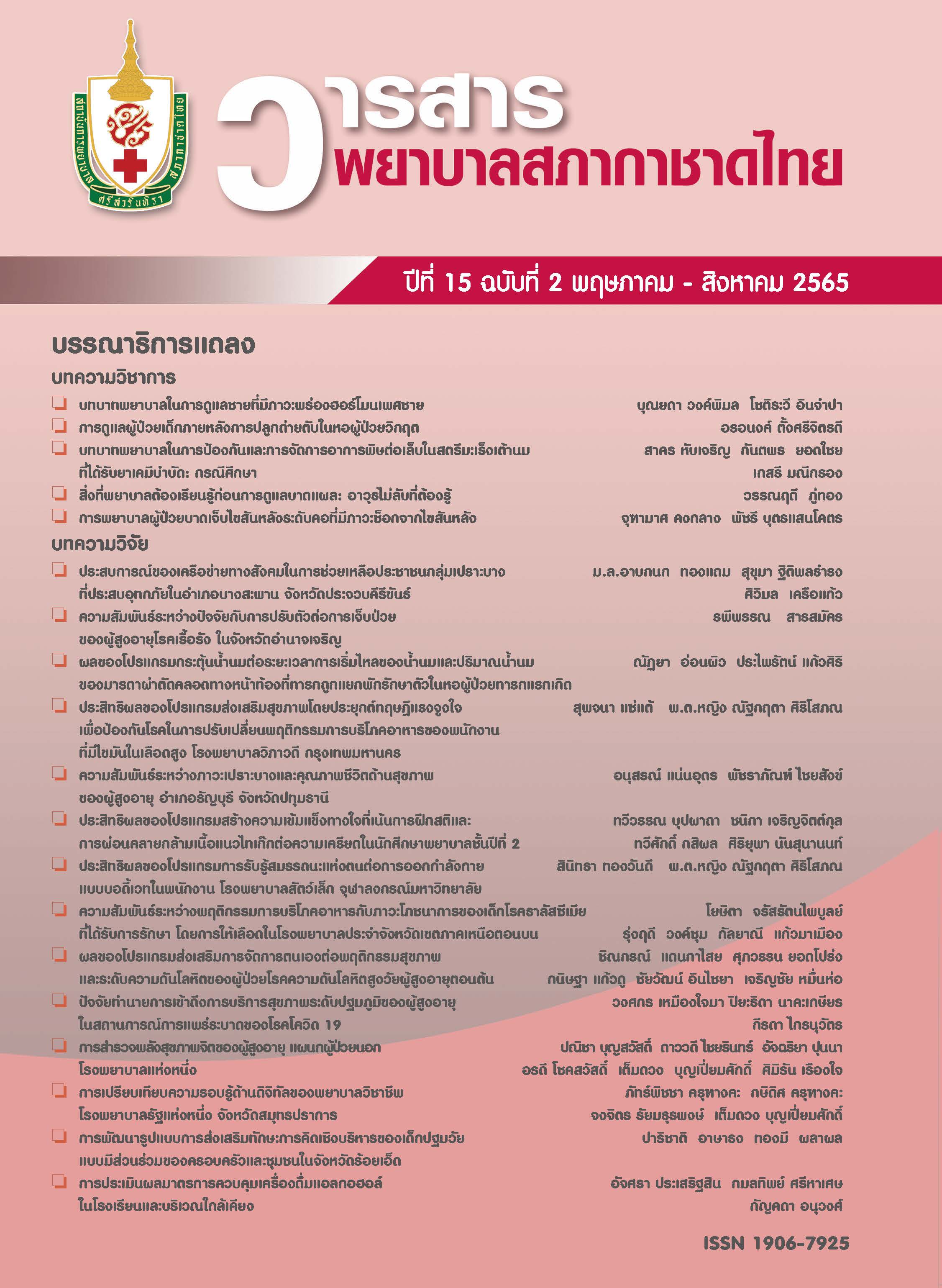Experiences of Social Networks in Assisting Vulnerable People, during Floods in Bang Saphan District, Prachuap Khiri Khan Province
Keywords:
social network, vulnerable group, flood, disasterAbstract
This qualitative research studies the experience of social networks in assisting vulnerable groups, residing in Bang Saphan District, Prachuap Khiri Khan Province during floods. The data collection was conducted by focus group discussions and in-depth interviews using semi-structured interview guided questions. Key informants included 15 healthcare providers, 12 government officers, 13 non-profit organization officers and volunteers, and 13 community leaders and local politicians were recruited through the purposive sampling and snowball techniques. The data were analyzed using content analysis according to Giogi’s method. The study revealed that the social networks played roles in assisting vulnerable groups by preparing, monitoring, warning, and helping them evacuate to safe areas before disasters occurred. The study also included searching and rescuing, and distributing relief supplies, and referring to appropriate assistance during disasters, and providing rehabilitation after disasters. Moreover, the social network wants to develop collaboration in caring for vulnerable groups more effectively by establishing an incident command system for working together, contributing to the community disaster plan, and rehearsing with vulnerable groups for participation and developing the vulnerable group database for assisting during a disaster. Nurses can promote the social network participation in assisting vulnerable people by learning to work together with other under the incident command system, contributing the community disaster plan and rehearsing with vulnerable people to participate and collaborate to develop a vulnerable groups database.
References
Panatama D, Jumparwai S. Effect and mental health problems after the flooding of people, Ban Phak Kat Ya, Maloeng Sub-District, Selaphum District, Roi Et Province. Journal of Health Science and Community Public Health 2020;3(2):50-9. (in Thai)
Tongcum D, Aegwatpanit C, Roongrattanaubon K, Wongtai P, Treerittiwittaya K, Chaisaeng P, et al. A study on adaptation approach of people in Chanthaburi province both before and after the flood. Rajabhat Rambhai Barni Research Journal 2018; 12(2):177-89. (in Thai)
Tongtham A, Kerdmongkol P, Amnatsatsue K, Jirapongsuwan A, Nanthamongkolchai S. Flood preparedness behavior among older people with chronic diseases in a flood prone area of Thailand. E Asian J Trop Med 2019;50(4):786–92.
Kunnu W. The development of participation network in flood prevention: the development of participation network in flood prevention, a case study of Kanchanadit District, Suratthani Province. Parichart Journal 2018;31(1):163-81. (in Thai)
Yodsuban P, Nuntaboot K. Community-based flood disaster management for older adults in southern of Thailand: a qualitative study. Int J Nurs Sci 2021;8(4):409-17.
Bubpa N, Nuntaboot K, Boonsawasdgulchai P, Benner M. Investigating the experience of local community networks of disaster self-management: a qualitative study in Thailand. Indian J Publ Health 2020;64(4):381-85. doi: 10.4103/ijph.IJPH_92_20
Sribun W, Taengsuwan P, Piromla P, Prombarn W, Udomchokechai S, Chaicharnyut A. People’s participation network in disaster management at Tambon Krung Ching, Amphoe Nopphitam, Nakhon Si Thammarat. Journal of Yala Rajabhat University 2017;12(1):45-59. (in Thai)
World Health Organization (WHO), Western Pacific Region; International Council of Nursing (ICN). ICN framework of disaster nursing competencies. Geneva, Switzerland: WHO and ICN; 2009.
Siriyothiphan J. The development of health service model for flood disaster victims at Bangsaphan Hospital, Bang Saphan District, Prachuap Khiri Khan Province. Reg 4-5 Med J 2018;37(2):120-35. (in Thai)
Disaster Prevention and Mitigation Plan Committee of Prachuap Khiri Khan Province. Disaster prevention and mitigation plan of Prachuap Khiri Khan Province: Fiscal Year 2021 [Internet]. 2021 [cited 2022 Jul 23]. Available from: https://www.disaster.go.th/ upload/download/file_attach/5fad08b150dfd.pdf. (in Thai)
Plodpluang U. Data analysis in phenomenology studies. Nursing Journal of the Ministry of Public Health 2013;23(2):1-10. (in Thai).
Oumtanee A. Qualitative research in nursing. 3rd ed. Bangkok: Chulalongkorn University Printing House; 2016. (in Thai).
Boontong T. Cave model for thirteen wild boars management at Thum Luang-Khun Nam Nang Non Forest Park, Pong Pha, Mae Sai district, Chiang Rai Province. CMJ 2020;12(3):1-16. (in Thai)
Wichaipa K, Kamolvej T, Luangprapat W, Prukpong M. The work flow of emergency operation center for floods and mudslides: a case study of local government in Phrae. Journal of Politics, Administration and Law 2016;8(2):419-61. (in Thai)
Worachat D, Nuntapanich C, Prasanthong R, Kunchusawad P. Development of public health emergency and disaster operations center: Chachoengsao Province. J Prapokklao Hosp Clin Med Educat Center 2018;35(2):190-202. (in Thai)
Jirarode A, Rungreangkulkij S. The guideline of health care service, vulnerable groups in disaster victims, recovery phase: case study in the flood. The Journal of Psychiatric Nursing and Mental Health 2017;31(2):31-46. (in Thai)
Downloads
Published
Issue
Section
License
Copyright (c) 2022 Srisavarindhira Thai Red Cross Institute of Nursing

This work is licensed under a Creative Commons Attribution-NonCommercial-NoDerivatives 4.0 International License.
เนื้อหาบทความหรือข้อคิดเห็นต่างๆ ในวารสารพยาบาลสภากาชาดไทยนี้ เป็นความคิดเห็นของผู้เขียนบทความ ไม่ใช่ความเห็นของกองบรรณาธิการ หรือสถาบันการพยาบาลศรีสวรินทิรา สภากาชาดไทย






